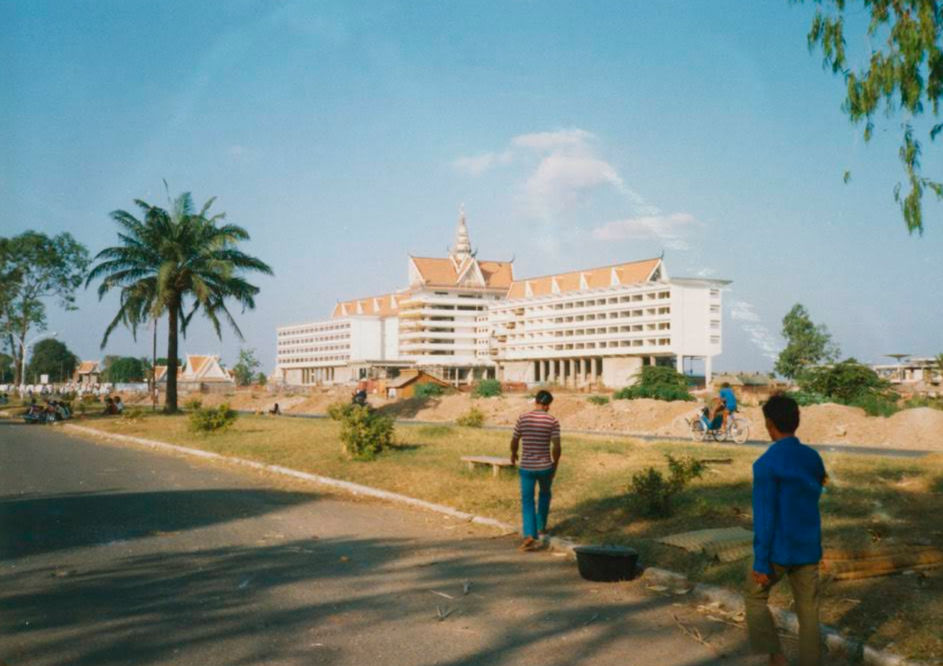The Everlasting Spirit of Hotel Cambodiana: Phnom Penh’s Living Monument
- Voyageuse Passion

- Jul 24
- 3 min read
Rising regally along Phnom Penh’s riverside, Hotel Cambodiana stands as more than an address—it is a chronicle inscribed with Cambodia’s greatest expectations and historic struggles.

Initially, Sihanouk’s modest dreams encountered economic realities. The plan for ten bungalows—sketched by the King himself—proved unsustainable. It was Lu Ban Hap who, sensing the tides of modernity, urged the monarch to think bigger. “A proper hotel," Hap argued, “would be commercially viable.” With the support of Tourism Minister Ang Kim Khoan and the transformation of SOROTEL into a joint venture with investments from the National Bank of Cambodia, the royal dream swelled to fit the nation's ambitions.
Architectural Ambitions: Khmer Identity Meets Modernity
The hotel’s design became a contest of Cambodian identity. While the Ministry of Public Works favored a modernist high-rise, Lu Ban Hap, after contemplative strolls alongside the Mekong, resolved to honor the city’s silhouette with a structure echoing the Khmer roofs of pagodas and palaces.
“A tower would be a foreign body,” he insisted, embedding Cambodian culture into the concrete and angles.
Construction began in 1966 on reclaimed land, with the hotel elevated on pillars to capture the river’s breezes and views. Yet as plans progressed, debates continued between architect and king—most notably on room size and utility. The result was a distinctive compromise: each room had a balcony for shade, with generous communal salons at the heart of the building.
Interrupted Grandeur and Political Upheaval
The Hotel Cambodiana opened its north wing in 1970, its ambition intact but the nation in flux. That same year, General Lon Nol swept Sihanouk from power. The hotel, a budding symbol of Cambodian progress, found itself transformed—walled, repurposed as military barracks, its opening gala postponed indefinitely

As the country slid into turmoil, the building became a shelter for refugees, then, under Khmer Rouge rule, was abandoned and used intermittently for fertilizer storage.
Through it all, its pillars remained—a silent witness to Phnom Penh’s darkest years, yet never fully erased.
Rebirth in a New Era
A new day dawned in 1988, when Singaporean investors Stephen Lek and Lim Ban Thoon re-envisioned the Cambodiana. Traditions were honored: the Khmer façade remained, pagoda-inspired motifs returned to lobbies and rooms, and the grounds echoed once again with voices from around the world.

The early 1990s proved a golden era. Diplomats, celebrities, and United Nations officials streamed in—Hotel Cambodiana becoming the de facto headquarters for the nation’s reconstruction during the UNTAC period. Luminaries from François Mitterrand to Jackie Chan graced its halls, reaffirming its place in contemporary history.
Legacy and Enduring Presence
In 2005, the baton passed to the Royal Group of Companies, a Cambodian entity determined to continue the hotel’s story. Through renovations, expansions, and modernization efforts, the Cambodiana has aged gracefully, preserving its architectural lineage while adapting to shifting times.
The hotel today stands not just as Phnom Penh’s foremost riverfront residence, but as a living repository of the journey—of dreams imagined, postponed, and reborn. Its ceilings hold the echoes of both royal banquets and hurried war councils; its salons, a tapestry of meals, meetings, and milestones that have shaped Cambodia’s destiny.
Conclusion
To walk the grounds of Hotel Cambodiana is to trace Cambodia’s past—its hopes, upheavals, resilience, and renewal. In every carved roofline and sunlit corridor, the spirit of a nation endures.
All direct historical details and architectural insights are derived from the original article by Willimann Cyberhome, interviews with architect Lu Ban Hap, and corroborating public records and history sources.







Comments